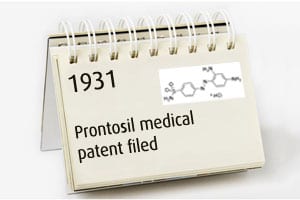 Few drugs can stake a genuine claim for inspiring the rise of modern medicine and the use of artificial, lab-created products to replace the organic compounds and risky surgeries of a more simpler time.
Few drugs can stake a genuine claim for inspiring the rise of modern medicine and the use of artificial, lab-created products to replace the organic compounds and risky surgeries of a more simpler time.
One that is justifiably up there among the most important pharmaceutical breakthroughs, however, is Prontosil – a compound that revolutionised not only patient outcomes, but also the very idea behind medicines themselves.
There had been some signs of progress in the early 19th century, when German chemist Friedrich Wöhle managed to synthesise the compound urea in 1828, demonstrating for the first time that a molecule found in living organisms could be created without biological starting materials.
This opened the gates for scientists to experiment and create a series of artificial (and often toxic) compounds, although it was some time before the idea of using such a synthesised product to help treat illnesses surfaced.
Perhaps one of the first big health-related developments in this field was that of another German chemist, Paul Ehrlich, in 1906, when he worked out the chemical structure of the white crystalline compound atoxyl, which had been used to treat a variety of illnesses.
Once Ehrlich had worked out that compounds were built from such structures, he concluded that this basic design could be modified, changing the way the compound worked, and potentially creating an agent that could target a specific disease.
He called this Nobel Prize winning idea his ‘magic bullet’ theory, and it was this technique that led Ehrlich to develop salvarsan from an organic arsenic compound as a targeted therapy to treat syphilis.
Salvarsan marked a giant leap forward in healthcare, offering the first real treatment against a then endemic disease, but there were still very real problems, mainly involving its distribution.
Doctors had to dissolve the compound in several hundred milliliters of pure, sterilised water and then administer it intravenously – something that just wasn’t sustainable as a standard practice at the time.
The magic bullet theory had to spark further development, and the next major advance was one that transformed the treatment of infections across the world.
Prontosil’s use as a medicine in humans came from the work of Bayer’s Gerhard Domagk, another German scientist, whose research involved a compound called sulfonamidochrysoidine, which had initially been synthesised by two other chemists at Bayer: Josef Klarer and Fritz Mietzsch.
Sulfonamidochrysoidine had demonstrated some success in treating mice with infection, and Bayer’s parent company IG Farben filed a German patent for its use as a medicine under the name Prontosil on Christmas Day in 1932.
However, according to his biography on the Nobel Prize website, Domagk wasn’t certain that Prontosil’s effect in mice would translate to humans, and it took an incident close at home to convince him of the molecule’s medical potential.
Near the end of 1935, Domagk’s daughter Hildegard fell while holding a needle, causing it to stick in her hand and lead to a streptococcal infection – caused by the same bacteria that Prontosil had proved effective in treating in mice.
Rather than let doctors amputate her arm, Domagk gave her the compound he had been working on, after which she made a complete recovery.
Soon after, Domagk published the positive results of clinical trials involving other patients, omitting the story involving his daughter.
There was some amount of scepticism at the time, but Prontosil’s ability to tackle infections was repeated at a hospital in the UK, before gaining widespread fame when it was used to treat a severe infection in the son of US President Franklin D Roosevelt.
Available as a water-soluble sodium salt, Prontosil became the first commercially available antibacterial antibiotic, opening a new era in medicine, and saving countless lives.
The story didn’t stop there, and scientists at the Pasteur Institute took an even greater leap into modern medicine shortly after Prontosil’s launch on to the market by metabolising the compound to just its active ingredient sulphanilamide – a much simpler molecule that could be produced as an oral drug and was far easier and cheaper to mass produce under the name Prontylin.
This method of production was an essential part of ensuring Prontosil’s legacy as one of the first products we could truly recognise as a modern medicine.
And although Bayer may herald the drug’s history and importance, it was a discovery that did not have a particularly financial benefit for the company.
The company may have held the rights to the non-metabolised Prontosil, but sulphanilamide’s patent had long expired, and once it was common knowledge that it was actually this active ingredient that treated infections rather than the whole drug, generic sulphanilamide products cropped up to fill the market.




